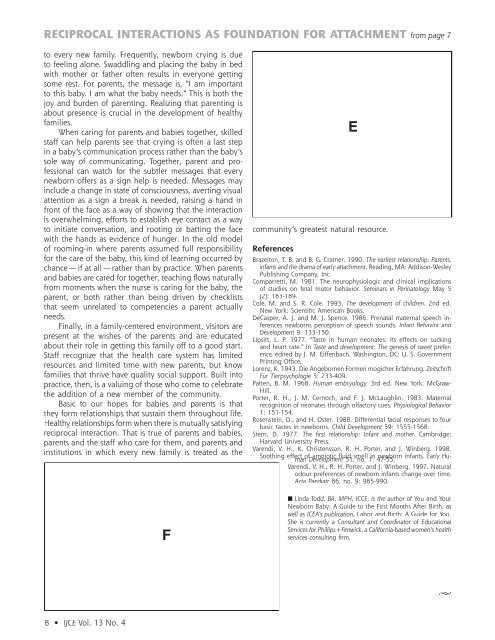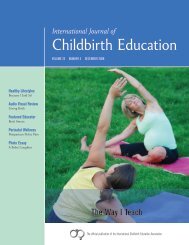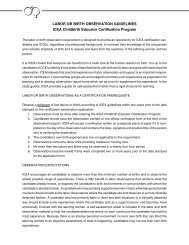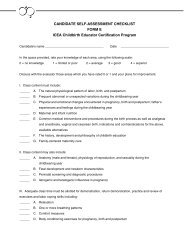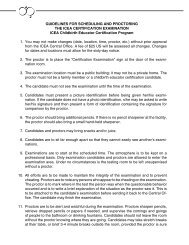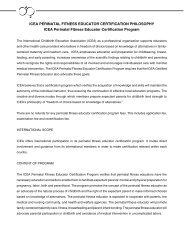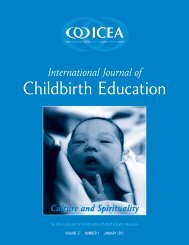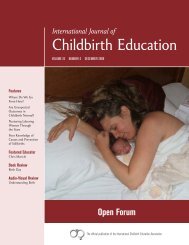JOURNAL - International Childbirth Education Association
JOURNAL - International Childbirth Education Association
JOURNAL - International Childbirth Education Association
Create successful ePaper yourself
Turn your PDF publications into a flip-book with our unique Google optimized e-Paper software.
RECIPROCAL INTERACTIONS AS FOUNDATION FOR ATTACHMENT from page 7<br />
to every new family. Frequently, newborn crying is due<br />
to feeling alone. Swaddling and placing the baby in bed<br />
with mother or father often results in everyone getting<br />
some rest. For parents, the message is, “I am important<br />
to this baby. I am what the baby needs.” This is both the<br />
joy and burden of parenting. Realizing that parenting is<br />
about presence is crucial in the development of healthy<br />
families.<br />
When caring for parents and babies together, skilled<br />
staff can help parents see that crying is often a last step<br />
in a baby’s communication process rather than the baby’s<br />
sole way of communicating. Together, parent and professional<br />
can watch for the subtler messages that every<br />
newborn offers as a sign help is needed. Messages may<br />
include a change in state of consciousness, averting visual<br />
attention as a sign a break is needed, raising a hand in<br />
front of the face as a way of showing that the interaction<br />
is overwhelming, efforts to establish eye contact as a way<br />
to initiate conversation, and rooting or batting the face<br />
with the hands as evidence of hunger. In the old model<br />
of rooming-in where parents assumed full responsibility<br />
for the care of the baby, this kind of learning occurred by<br />
chance — if at all — rather than by practice. When parents<br />
and babies are cared for together, teaching flows naturally<br />
from moments when the nurse is caring for the baby, the<br />
parent, or both rather than being driven by checklists<br />
that seem unrelated to competencies a parent actually<br />
needs.<br />
Finally, in a family-centered environment, visitors are<br />
present at the wishes of the parents and are educated<br />
about their role in getting this family off to a good start.<br />
Staff recognize that the health care system has limited<br />
resources and limited time with new parents, but know<br />
families that thrive have quality social support. Built into<br />
practice, then, is a valuing of those who come to celebrate<br />
the addition of a new member of the community.<br />
Basic to our hopes for babies and parents is that<br />
they form relationships that sustain them throughout life.<br />
Healthy relationships form when there is mutually satisfying<br />
reciprocal interaction. That is true of parents and babies,<br />
parents and the staff who care for them, and parents and<br />
institutions in which every new family is treated as the<br />
F<br />
community’s greatest natural resource.<br />
References<br />
E<br />
Brazelton, T. B. and B. G. Cramer. 1990. The earliest relationship: Parents,<br />
infants and the drama of early attachment. Reading, MA: Addison-Wesley<br />
Publishing Company, Inc.<br />
Comparretti, M. 1981. The neurophysiologic and clinical implications<br />
of studies on fetal motor behavior. Seminars in Perinatology May 5<br />
(2): 183-189.<br />
Cole, M. and S. R. Cole. 1993. The development of children. 2nd ed.<br />
New York: Scientific American Books.<br />
DeCasper, A. J. and M. J. Spence. 1986. Prenatal maternal speech inferences<br />
newborns perception of speech sounds. Infant Behavior and<br />
Development 9: 133-150.<br />
Lipsitt, L. P. 1977. “Taste in human neonates: Its effects on sucking<br />
and heart rate.” In Taste and development: The genesis of sweet preference,<br />
edited by J. M. Eiffenbach. Washington, DC: U. S. Government<br />
Printing Office.<br />
Lorenz, K. 1943. Die Angebornen Formen mogicher Erfahrung. Zeitschrift<br />
Fur Tierpsychologie 5: 233-409.<br />
Patten, B. M. 1968. Human embryology. 3rd ed. New York: McGraw-<br />
Hill.<br />
Porter, R. H., J. M. Cernoch, and F. J. McLaughlin. 1983. Maternal<br />
recognition of neonates through olfactory cues. Physiological Behavior<br />
1: 151-154.<br />
Rosenstein, D., and H. Oster. 1988. Differential facial responses to four<br />
basic tastes in newborns. Child Development 59: 1555-1568.<br />
Stern, D. 1977. The first relationship: Infant and mother. Cambridge:<br />
Harvard University Press.<br />
Varendi, V. H., K. Christensson, R. H. Porter, and J. Winberg. 1998.<br />
Soothing effect of amniotic fluid smell in newborn infants. Early Hu-<br />
man Development<br />
51, no. 1: 47-55.<br />
Varendi, V. H., R. H. Porter, and J. Winberg. 1997. Natural<br />
odour preferences of newborn infants change over time.<br />
Acta Paediatr 86, no. 9: 985-990.<br />
■ Linda Todd, BA, MPH, ICCE, is the author of You and Your<br />
Newborn Baby: A Guide to the First Months After Birth, as<br />
well as ICEA’s publication, Labor and Birth: A Guide for You.<br />
She is currently a Consultant and Coordinator of <strong>Education</strong>al<br />
Services for Phillips+Fenwick, a California-based women’s health<br />
services consulting firm.<br />
<br />
8 • IJCE Vol. 13 No. 4


